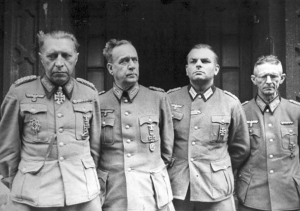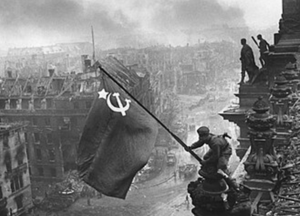Countdown to Surrender: How World War II Ended in Europe
May 1, 1945, Berlin. Hitler’s corpse, partly burned, lay in an unmarked corner of the sprawling garden above his bunker. Later that day and in another part of the bunker, Joseph Goebbels, one of the two most senior Nazis to stick with Hitler till the very end, was to kill himself, his wife Magda and their six children. Martin Bormann, the other Nazi top gun, chose to lie low till late that evening, then sneaked out of the bunker and into the night, along with a few others, hoping to make his way past countless Red Army patrols to relative safety. He was killed early the next morning. The Thousand-Year Reich lay in a heap on Berlin’s gnarled roads.
And yet the Nazi resistance sputtered on for some time. Partly because the news of Hitler’s death had not spread yet. It was not until 1.55 a.m. on May 2 or nearly 36 hours after Hitler had killed himself on April 30, that a broadcaster on Grossdeutsche Rundfunk (Reich Broadcasting Corporation) made what turned out to be its last ever radio broadcast. From its studio inside a bunker, Rundfunk announced “The Fuhrer is dead”. For good measure, though, he signed off with “Long live the Reich!”
Even after this, since a great many German homes had no electricity at that point, the news didn’t spread fast enough. And, with Hitler absent from the scene, even the last semblance of a unified chain of command in either the Wehrmacht or the Nazi Party had dropped out of sight.
A disgraced Herman Goering was cooling his heels in house arrest in far-away Obersalzberg, weighing the different options he believed he still had. Heinrich Himmler was in hiding, furiously trying to negotiate a bargain deal (via the Swedish consulate in Lubeck) with the Western Allies: a deal that, he hoped, would install him as post-Hitler Germany’s new Fuehrer in return for Himmler joining hands with the US and British armies against Stalin’s Red Army.
A fully frazzled Wehrmacht was finally spared the torment of having to listen to Hitler’s insane rants about how Germany could still win the war, but the Fuehrer’s delusions had clearly rubbed off on many of his military commanders, obliging them to clutch at straws even as the Red Army went on pulverising them.
But of course there were other, even weightier, reasons why many Germans seemed intent on fighting to death. Years of intense Nazi propaganda had dinned it in them that a German defeat could only mark the death of German civilisation, indeed of European civilisation – and so life couldn’t really be worth living any more.
At the same time there was the chilling realisation in an increasing number of Germans that the victors – the Soviets, more than the others – could well wish to visit upon them what Germany had done to the occupied territories, to East Europe and the Soviet Union.
Finally, there was a dreadful effect of Hitler’s snarls – ‘You deserve to hang if you want to give up the fight’ being the most temperate among them’ – at those who permitted themselves to contemplate surrender.
Hitler’s words were picked up and amplified many times over by Goebbels and sundry other Nazi potentates, and fanatical SS men were scouring the streets of Berlin even at this late stage, ready to string up on the nearest tree anyone who dared put out the white flag to the victors.

Red Army soldiers in a Berlin neighbourhood in late April, 1945. Photo: Author provided
A week crowded with surrenders
But the game was up, and even the die-hard Nazi knew it now. Early on May 2, General Helmuth Weidling, commander of the Berlin Defence Area, surrendered to General Vasily Chuikov of the Red Army. Later that day, the commanding officers of the two armies of Army Group Vistula surrendered to the Western Allies.
At 2 pm the same day at Caserta, Italy, the unconditional surrender of nearly 1 million German men, stationed in Italy and Austria, to Field Marshal Harold Alexander of the British Army took effect under an agreement reached between the two sides on April 29.
The flood gates opened after that. On May 4, British Field Marshal Bernard Montgomery at Bremen took the surrender of all the German forces stationed in northwestern Germany, Schleswig-Holstein and Denmark, totalling another million men.
The next day GrossAdmiral Karl Doenitz, lately designated by Hitler as the German Head of State after him, ordered the cessation of all naval operations by the German navy. May 5 saw the capitulation of German armies in Bavaria, followed by those in the Netherlands. The same day, the intrepid men and women of the Czech resistance rose against the Nazi occupiers, and on May 6, the Red Army launched its Prague offensive.
Later on May 6, Breslau, besieged for months but not vanquished until then, gave itself up to the Soviets. And the same day Reichmarshall Goering surrendered to the American General Carl Spatz near the Austro-German border.

General Helmuth Weidling (left) with aides after his surrender. Photo: Author provided.
No Versailles this time
German, or otherwise Nazi-inspired, resistance continued to smoulder for a couple more weeks in isolated pockets of southern and eastern Europe, notably in what then was Yugoslavia. But there was no question that the battle against Hitler had been won.
A war-weary world needed to be notified of that great victory without further ado. But, for that to happen, there had to be a formal cessation of hostilities across all fronts and theatres of war: in other words, an armistice was required to be signed between Germany and the Allies.
But that armistice, the Allies had made up their minds a long time before the war ended, was not to be a mere covenant for a ceasefire or even for lasting peace – as was the case in 1918 at the end of World War 1 – but an unconditional surrender of Germany to the Allied powers who were to give the conquered nation no quarters on any issue whatsoever.
The 1918 armistice was followed by the Treaty of Versailles of 1919. Prolonged, even tortuous, negotiations around peace terms had gone on between the victors and the vanquished for months leading up to Versailles. (It’s quite another matter that those discussions failed to secure for Germany an even remotely honourable peace.)
But, after he rose to power, Hitler had nonchalantly blown the terms of that treaty to smithereens. The Second World War, the Allied powers had resolved by 1944, was not going to have another Versailles as its sequel. This time there were to be no negotiations. Germany would merely be asked to sign on the dotted line. Considering how Hitler had waged his war, the Allies could hardly be faulted for this decision.

A Red Army soldier raises the red flag over the fallen Reichstag. Photo: Author provided.
Through the first half of 1944, the European Advisory Commission (EAC) , composed of representatives of the Soviet Union, the United States, and the United Kingdom, had worked on several drafts before it agreed on a format for the surrender document. The Yalta Conference of February, 1945 further refined some of the provisions of the document.
The document was to commit the German government and the military high command to:
- An acknowledgement of the complete defeat of the German armed forces on land, at sea, and in the air;
- Evacuation from all territories outside the German boundaries as they stood at December 31, 1937 (that is, before the annexation of Austria and the Czech Sudetenland);
- A complete surrender by the German government of (virtually all) its powers and authority to the Allied powers in (practically) all matters of state; and
- The recognition that the Allies were free to reorganise the German state and the German armed forces on lines they deemed appropriate.
As the war entered its final weeks, however, the Allied governments came to recognise that, with the German state fully stripped down, there would likely be no post-Nazi civil authority capable of signing the instrument of surrender in the form envisaged, still less of putting its provisions into effect.
The EAC text, therefore, was substituted by a simplified instrument of Germany’s unconditional surrender to the Allies, and it was in this format that German capitulation came to be recorded in May, 1945.
Eventually, though, the EAC format was to find its use in another historic document: the Declaration regarding the Defeat of Germany, or, simply, the Berlin Declaration, of June 5 1945, in terms of which the four Allied powers – the USA, the USSR, the UK, and France – jointly assumed de jure supreme authority over Germany and asserted the legitimacy of their joint decisions on all issues related to the country’s boundaries and its administration.
As it turned out, however., Germany was obliged to sign its military surrender not once but twice, over two successive days in May 1945. The story of those two signings is as fascinating as it is instructive. But that is a story for another day.
Anjan Basu can be reached at basuanjan52@gmail.com.
Read the second part of the two-part series here.
This article went live on May seventh, two thousand twenty five, at twenty-four minutes past eleven in the morning.The Wire is now on WhatsApp. Follow our channel for sharp analysis and opinions on the latest developments.




